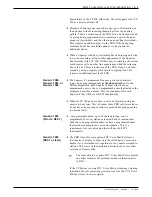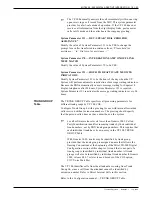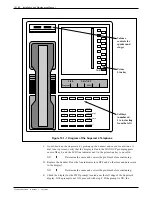
OVERFLOW — No access code need be entered for this hunt group.
HUNTING (TERMINAL/CIRCULAR) — Define the hunt group to be circular.
HUNT GROUP TYPE — Enter STN/SET for the hunt group type.
HUNT GROUP NAME — (Generic 1003 only) Leave this entry blank.
EXTENSION NUMBERS — Enter all of the extension numbers of the MIC ports used for
MWI. Do not include the extension used for CPI or any other extension.
■
Trunks and Trunk Groups
Use CDE form 14, NON-DIAL-IN TRUNKS, to configure any trunks that are to be answered
by the VP 300. Each individual trunk must have its own entry in the VP 300 TRUNK GROUP
Table. Configure each trunk as follows:
1.
Set the answer points for DAY, NIGHT 1, and NIGHT 2 service to the MIOC port hunt
group number according to when the trunk is to be answered by the VP 300.
2.
Note the trunk number so that this number may be entered in the VP 300 TRUNK GROUP
Table. For Generic 1003 only, the trunk Name entry must be left blank.
For Generic 1003 only, use CDE form 15, DIAL-IN TRUNKS, to check the names of any
dial-in trunks to be answered by the VP 300. The Name entries for all such trunks should
be blank.
Except for Generic 1000, which does not allow naming of trunk groups, use CDE form 16,
TRUNK GROUPS, to check the names of any trunk groups containing trunks to be
answered by the VP 300. Be sure that any names assigned to these trunk groups follow the
naming conventions described in the beginning of this section.
■
Station Extensions
Certain COS options in the PBX may need to be enabled for individual employees so that they
can access the Adaptive Integration features. The features, and their associated COS options,
are described below.
•
In order to use Adaptive Integration for secondary answering of internal calls, employees
must be able to forward their phones to the MIC port hunt group. This requires that they be
assigned a COS with one or more of the following COS options enabled:
206 — Call Forwarding – Busy
207 — Call Forwarding – Don’t Answer
209 — Call Forwarding – Follow Me
☞
Forwarding is enabled or disabled, by mailbox holders, by means of feature access
codes, at the station itself. It is the responsibility of each individual to turn their
forwarding ON or OFF as the application requires.
Toshiba VP Systems
Release 7.1
July, 1994
10.1-18
Installation and Maintenance Manual
Summary of Contents for VP 300
Page 2: ......
Page 10: ......
Page 14: ......
Page 20: ...Toshiba VP Systems Release 7 1 July 1994 ...
Page 52: ...Toshiba VP Systems Release 6 1 February 1993 2 14 Installation and Maintenance Manual ...
Page 56: ...Toshiba VP Systems Release 7 1 July 1994 ...
Page 146: ......
Page 312: ...Toshiba VP Systems Release 7 1 July 1994 ...
Page 314: ......
Page 444: ......
Page 496: ......
Page 542: ......
Page 598: ...Toshiba VP Systems Release 6 1 February 1993 ...
Page 600: ...Toshiba VP Systems Release 6 1 February 1993 ...
















































